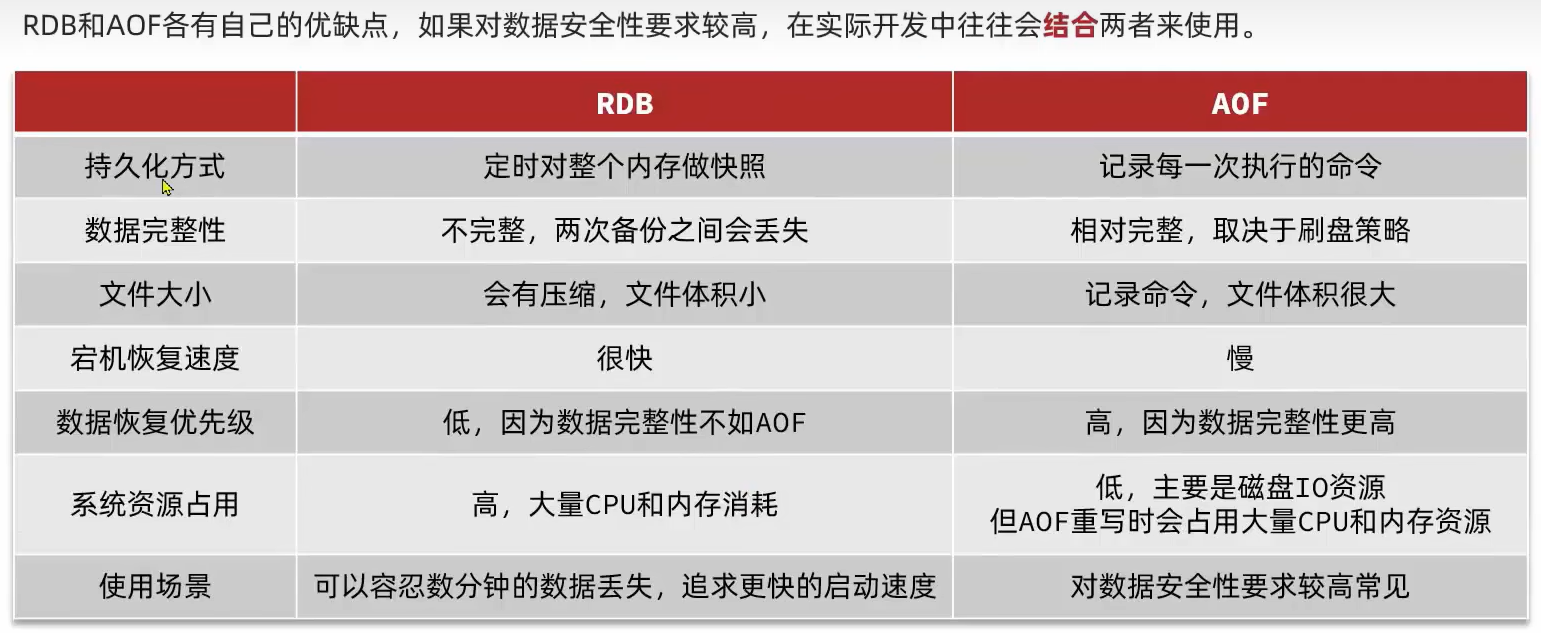Redis 持久化-实战
两种方式:
rdf :默认
save <seconds> <changes>
多长时间内 有几个操作就执行 后台save
rdbcompression yes
是否执行压缩 建议不开启,因为压缩会消耗CPU
dbfilename dump.rdb
数据文件名字
################################ SNAPSHOTTING ################################ # Save the DB to disk. # # save <seconds> <changes> [<seconds> <changes> ...] # # Redis will save the DB if the given number of seconds elapsed and it # surpassed the given number of write operations against the DB. # # Snapshotting can be completely disabled with a single empty string argument # as in following example: # # save "" # # Unless specified otherwise, by default Redis will save the DB: # * After 3600 seconds (an hour) if at least 1 change was performed # * After 300 seconds (5 minutes) if at least 100 changes were performed # * After 60 seconds if at least 10000 changes were performed # # You can set these explicitly by uncommenting the following line. # # save 3600 1 300 100 60 10000 # By default Redis will stop accepting writes if RDB snapshots are enabled # (at least one save point) and the latest background save failed. # This will make the user aware (in a hard way) that data is not persisting # on disk properly, otherwise chances are that no one will notice and some # disaster will happen. # # If the background saving process will start working again Redis will # automatically allow writes again. # # However if you have setup your proper monitoring of the Redis server # and persistence, you may want to disable this feature so that Redis will # continue to work as usual even if there are problems with disk, # permissions, and so forth. stop-writes-on-bgsave-error yes # Compress string objects using LZF when dump .rdb databases? # By default compression is enabled as it's almost always a win. # If you want to save some CPU in the saving child set it to 'no' but # the dataset will likely be bigger if you have compressible values or keys. rdbcompression yes # Since version 5 of RDB a CRC64 checksum is placed at the end of the file. # This makes the format more resistant to corruption but there is a performance # hit to pay (around 10%) when saving and loading RDB files, so you can disable it # for maximum performances. # # RDB files created with checksum disabled have a checksum of zero that will # tell the loading code to skip the check. rdbchecksum yes # Enables or disables full sanitization checks for ziplist and listpack etc when # loading an RDB or RESTORE payload. This reduces the chances of a assertion or # crash later on while processing commands. # Options: # no - Never perform full sanitization # yes - Always perform full sanitization # clients - Perform full sanitization only for user connections. # Excludes: RDB files, RESTORE commands received from the master # connection, and client connections which have the # skip-sanitize-payload ACL flag. # The default should be 'clients' but since it currently affects cluster # resharding via MIGRATE, it is temporarily set to 'no' by default. # # sanitize-dump-payload no # The filename where to dump the DB dbfilename dump.rdb # Remove RDB files used by replication in instances without persistence # enabled. By default this option is disabled, however there are environments # where for regulations or other security concerns, RDB files persisted on # disk by masters in order to feed replicas, or stored on disk by replicas # in order to load them for the initial synchronization, should be deleted # ASAP. Note that this option ONLY WORKS in instances that have both AOF # and RDB persistence disabled, otherwise is completely ignored. # # An alternative (and sometimes better) way to obtain the same effect is # to use diskless replication on both master and replicas instances. However # in the case of replicas, diskless is not always an option. rdb-del-sync-files no # The working directory. # # The DB will be written inside this directory, with the filename specified # above using the 'dbfilename' configuration directive. # # The Append Only File will also be created inside this directory. # # Note that you must specify a directory here, not a file name. dir ./
aof:
port 7379 save "" daemonize no appendonly yes appendfilename "applenonly.aof" #appendfsync always appendfsync everysec #appendfsync no

手动给aof瘦身命令:
连接客户端
redis-cli -p xxxx
bgrewriteaof # background rewrite aof ,这个命令让aof文件压缩
在默认配置下redis 会自动执行这个命令:
配置如下;
分别 是aof 文件增长一倍时 和 文件大小达到 64MB
auto-aof-rewrite-percentage 100 auto-aof-rewrite-min-size 64mb
结论:

以上引自黑马程序员


 浙公网安备 33010602011771号
浙公网安备 33010602011771号